What Are the Best Practices for Rehabilitating Rescued Parrots by Species?
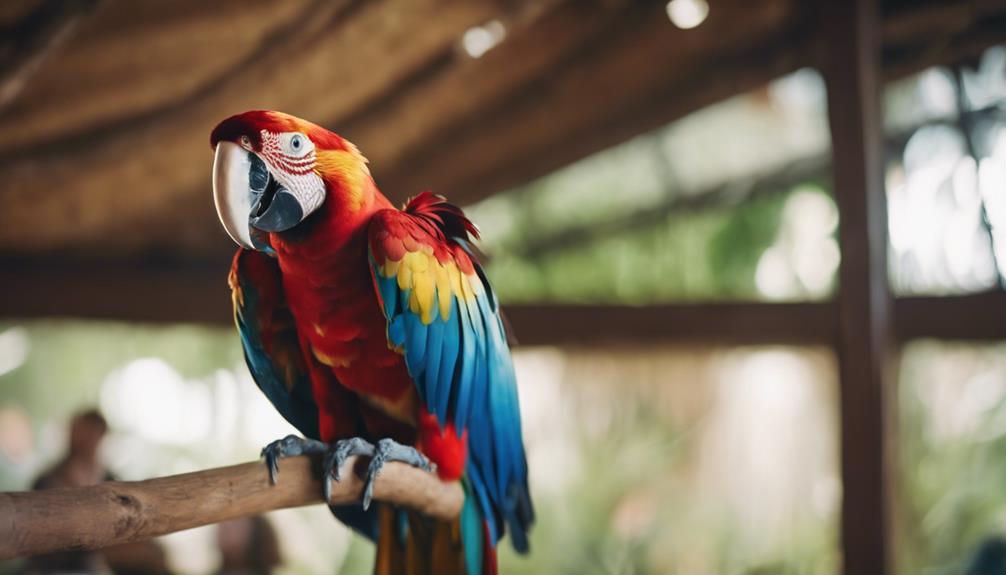
Best Practices for Rehabilitating Rescued Parrots by Species:
Tailored care for successful recovery.
Understanding Parrot Species Characteristics
Understanding the unique characteristics of different parrot species is essential for effectively rehabilitating rescued parrots. Behavior and habitat preferences play crucial roles in providing appropriate care and creating a suitable environment for these birds. Parrots exhibit diverse behaviors, ranging from social interaction to foraging habits. Some species are highly social and require companionship, while others prefer solitude. Understanding these behaviors helps in preventing stress and promoting mental well-being during the rehabilitation process.
Habitat preferences vary among parrot species, with some being arboreal and others ground-dwellers. Providing a habitat that mimics their natural environment is vital for their physical and psychological health. For example, arboreal species like the African Grey Parrot benefit from elevated perches and ample space for flying, whereas ground-dwelling species like the Kakapo require a more terrestrial setup with hiding spots. By tailoring the rehabilitation process to accommodate these habitat preferences, caretakers can ensure the well-being and successful reintegration of rescued parrots into suitable environments.
Tailoring Diet for Species-specific Needs
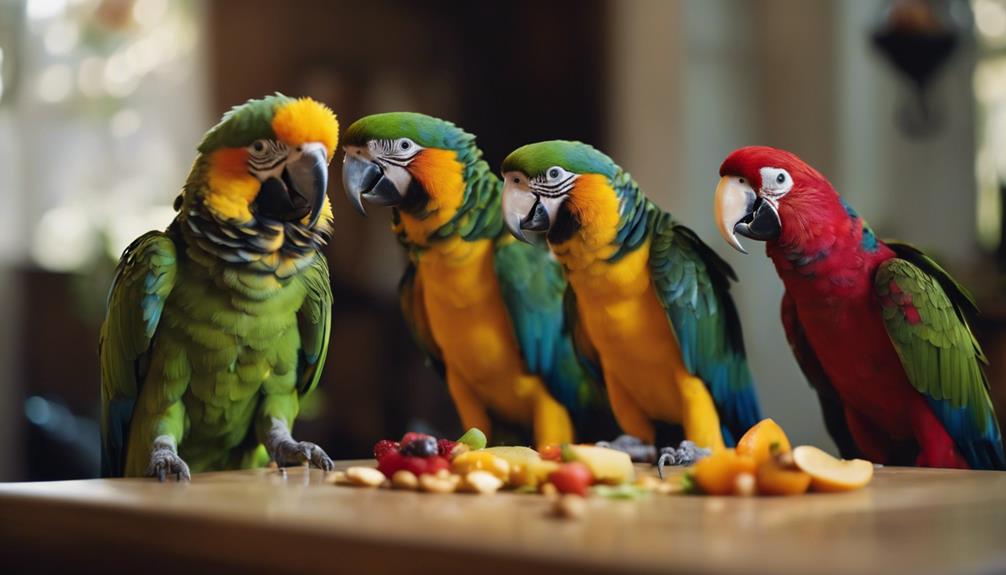
To effectively meet the needs of rescued parrots during rehabilitation, caretakers must tailor their diets to match the specific requirements of each parrot species. Nutritional requirements play a crucial role in the recovery process, ensuring that the parrots receive the essential nutrients for their health and well-being. Different parrot species have varying dietary needs, such as the high vitamin A requirements of macaws or the protein needs of African greys. Caretakers must provide a balanced diet that includes a variety of fruits, vegetables, nuts, seeds, and pellets to meet these specific needs.
Feeding schedules should be consistent, offering meals at regular intervals to maintain a routine that aids in the parrots' digestion and overall health. Portion control is also vital to prevent obesity and related health issues. Caretakers must monitor the parrots' food intake, adjusting portions as needed based on the individual bird's metabolism and activity level. By carefully tailoring diets to meet species-specific needs, caretakers can support the rehabilitation process and help rescued parrots thrive.
Creating Species-appropriate Housing Setups
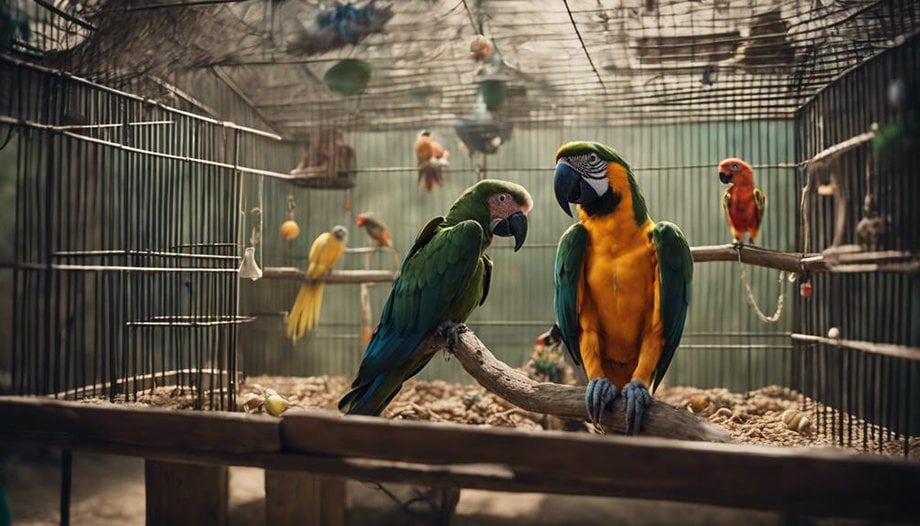
When creating species-appropriate housing setups for rescued parrots, it's crucial to consider the size and layout of the enclosure. Providing enough space for natural behaviors such as flying and perching is essential for the well-being of these birds.
Environmental enrichment, including toys and puzzles, can help stimulate their minds and prevent boredom, while offering a variety of natural perches can promote foot health and exercise.
Size and Layout
Creating species-appropriate housing setups for rescued parrots involves meticulous consideration of their size and behavioral traits to ensure optimal well-being in captivity. When setting up housing for parrots, keep in mind the following:
- Cage Size: Provide a spacious cage that allows for natural movements and wing-spreading.
- Perching Options: Include various perches of different diameters to promote foot health and exercise.
- Room Layout: Arrange the cage in a quiet area with natural light and away from drafts or direct sunlight.
- Play Areas: Incorporate toys, puzzles, and foraging opportunities to stimulate mental and physical activity.
- Safety Measures: Ensure the environment is free from toxic plants, small objects, or other hazards that could harm the parrot.
Environmental Enrichment
For optimal well-being in captivity, designing species-appropriate housing setups for rescued parrots requires meticulous consideration of their size, behavioral traits, and environmental enrichment needs. Providing foraging opportunities and interactive toys can engage the parrots' natural behaviors, promoting mental stimulation and reducing boredom.
Climbing structures offer physical exercise and mimic their natural habitat, while sensory stimulation through different textures, sounds, and colors enriches their environment. Including puzzle feeders and hiding treats can encourage problem-solving and satisfy their instinct to search for food. Regularly rotating and updating toys and enrichments prevent habituation and keep the parrots engaged.
Natural Perches
To ensure the well-being of rescued parrots in captivity, incorporating natural perches into their housing setups is crucial due to their importance in mimicking the birds' natural perching behaviors and supporting their physical health. When creating species-appropriate housing for parrots, consider the following:
- Branch variations: Provide perches of different thicknesses and textures to stimulate the birds' feet and prevent foot sores.
- Natural materials: Opt for untreated wood branches to mimic the feel of perching in the wild.
- Climbing opportunities: Include perches at varying heights to encourage natural movement and exercise.
- Play structures: Incorporate toys and interactive elements to promote mental stimulation and prevent boredom.
- Secure placement: Ensure perches are stable and correctly positioned to prevent accidents and injuries.
Implementing Behavioral Enrichment Activities

Behavioral enrichment activities play a crucial role in the rehabilitation of rescued parrots, providing mental stimulation and promoting natural behaviors essential for their well-being. When implementing enrichment activities for parrots, it is important to consider cognitive challenges, foraging opportunities, playful interactions, and sensory stimulation. These activities not only keep the birds engaged but also help in reducing stress and preventing behavioral issues.
| Enrichment Activity | Description |
|---|---|
| Puzzle Feeders | Engage parrots in problem-solving tasks to access food, mimicking natural foraging behaviors. |
| Interactive Toys | Provide toys that encourage play and exploration, stimulating both physical and mental activity. |
| Sensory Stations | Create stations with different textures, sounds, and objects to engage the parrot's senses and curiosity. |
Socializing Parrots Based on Species Traits
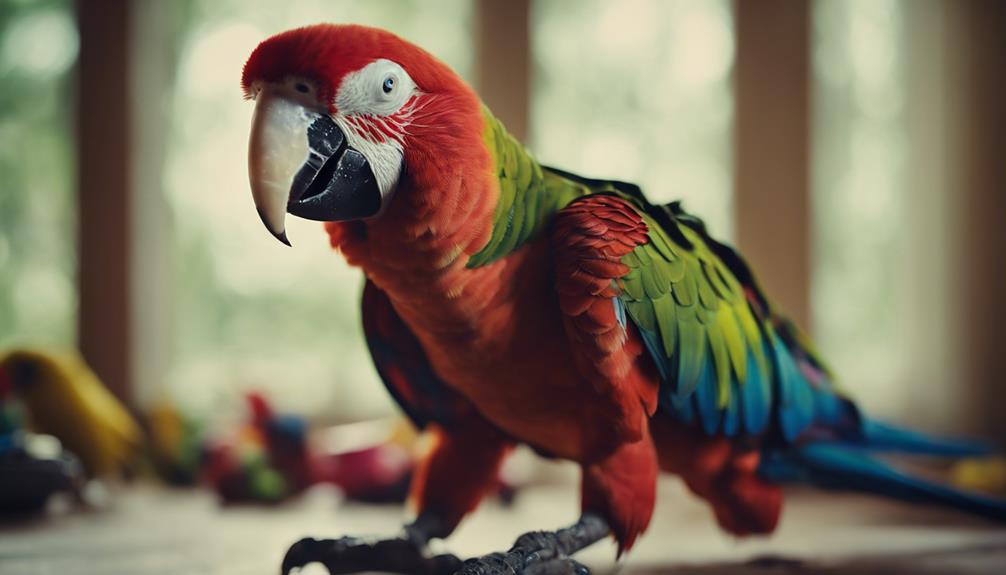
Socializing rescued parrots based on their species' inherent traits is a critical aspect of their rehabilitation process. Understanding the unique characteristics of each species is vital for successful socialization and bonding.
Here are some key strategies to consider:
- Species Bonding: Tailoring socialization techniques to match the natural behavior of the specific parrot species can help establish trust and build a strong bond.
- Observation and Adaptation: Behavioral modification requires keen observation of the parrot's responses to different stimuli, allowing for adjustments in the socialization approach as needed.
- Species-Specific Strategies: Implementing species-specific strategies such as providing suitable companionship or environmental enrichment can aid in the socialization process.
- Positive Reinforcement: Using positive reinforcement techniques like treats or praise can encourage desirable social behaviors and strengthen the bond between the parrot and caregiver.
- Consistency and Patience: Consistent interaction and patience are key elements in socializing parrots, as building trust and comfort takes time and effort.
Providing Veterinary Care for Different Species
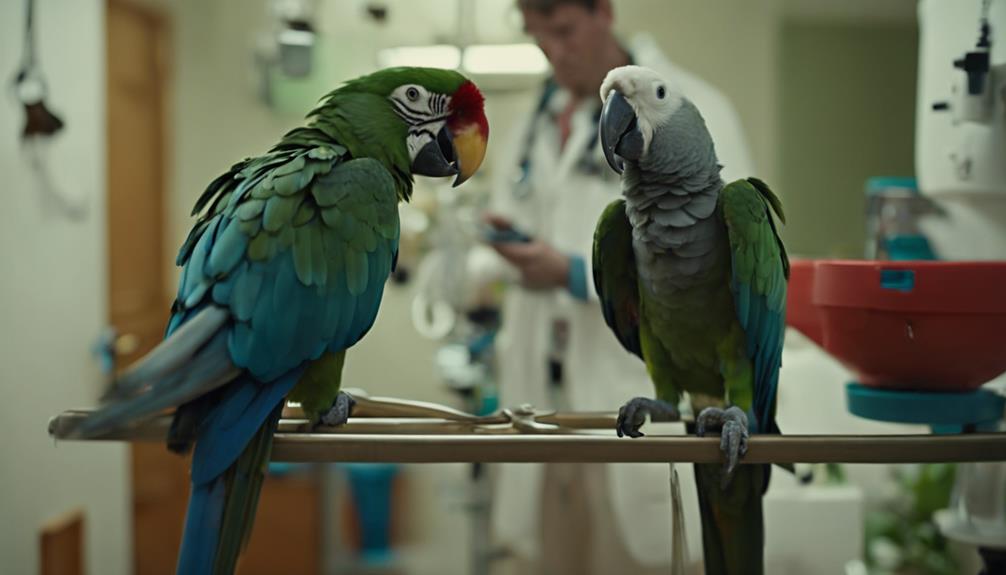
Avian veterinary expertise is crucial when caring for rescued parrots, as different species have unique medical requirements. Understanding species-specific medical needs enables veterinarians to provide tailored treatment plans for optimal health outcomes.
Implementing preventive health measures, such as regular check-ups and vaccinations, is essential in maintaining the well-being of parrots from diverse species.
Avian Veterinary Expertise
With the diverse range of parrot species under rehabilitation, avian veterinarians must possess specialized expertise in providing tailored veterinary care for each distinct species. Avian veterinary experts play a crucial role in understanding avian behavior and ensuring the successful rehabilitation of rescued parrots.
Some key aspects of avian veterinary expertise in species rehabilitation include:
- Knowledge of species-specific dietary requirements
- Understanding of unique behavioral traits in different parrot species
- Proficiency in handling and restraining various parrot species for medical procedures
- Ability to recognize species-specific signs of illness or distress
- Skill in developing customized treatment plans based on the specific needs of each parrot species
Species-Specific Medical Needs
Understanding the diverse medical needs of different parrot species is essential for providing precise veterinary care during the rehabilitation process. Feather health and nutritional requirements vary significantly among parrot species. For instance, some species may require specific dietary supplements to maintain optimal feather condition.
Additionally, reproductive behavior and hormonal imbalances should be carefully monitored and addressed by avian veterinarians during rehabilitation. Different species may exhibit distinct patterns of reproductive behavior, which can impact their overall health and well-being. Veterinarians must be knowledgeable about these species-specific medical needs to ensure the successful rehabilitation of rescued parrots.
Preventive Health Measures
To ensure the well-being of rescued parrots during rehabilitation, implementing preventive health measures tailored to the specific needs of each species is crucial. When providing veterinary care for different species of parrots, the following preventive health measures are essential:
- Preventive care: Regular check-ups and health screenings are vital for early detection of any potential health issues.
- Vaccination protocols: Following recommended vaccination schedules can help protect parrots from common diseases.
- Parasite prevention: Administering parasite prevention treatments is necessary to safeguard the birds from infestations.
- Nutritional counseling: Offering species-specific nutritional guidance ensures the parrots receive a balanced diet for optimal health.
- Regular monitoring: Continual monitoring of the parrots' health status allows for prompt intervention if any concerns arise.
Preparing Parrots for Release or Adoption
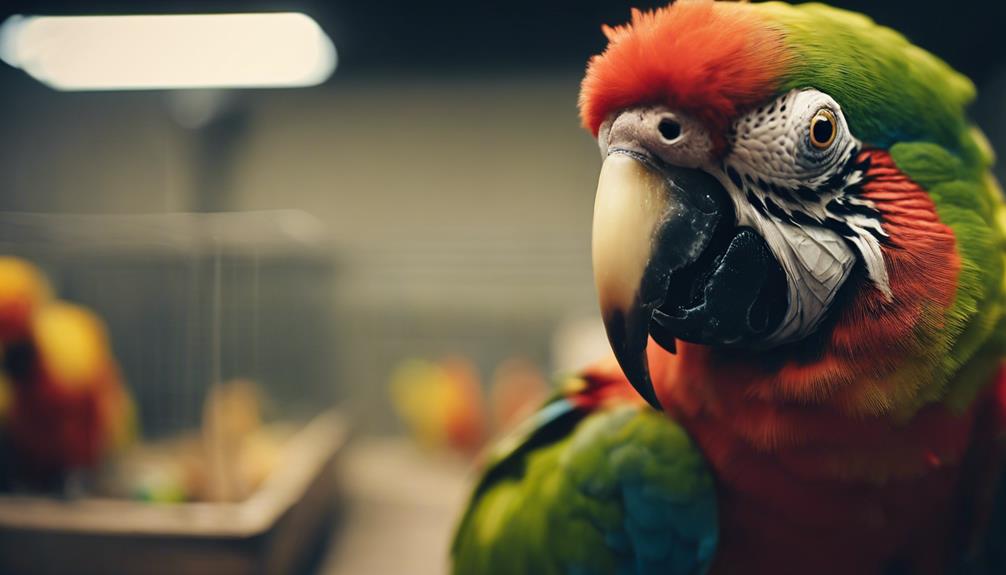
Parrots undergoing rehabilitation for release or adoption require a structured program tailored to their species-specific needs. When preparing parrots for release or adoption, it's essential to focus on behavioral rehabilitation and effective socialization techniques.
Behavioral rehabilitation plays a crucial role in ensuring that parrots can successfully integrate into their new environment. This process involves addressing any behavioral issues that may hinder their ability to thrive in the wild or in a domestic setting. Through positive reinforcement training and enrichment activities, parrots can learn essential skills and behaviors that will aid in their transition.
Socialization techniques are also vital in preparing parrots for release or adoption. By exposing them to various stimuli, such as different sounds, textures, and interactions, parrots can become more adaptable and resilient. This exposure helps them feel more comfortable and confident in unfamiliar situations, increasing their chances of a successful release or adoption.
Frequently Asked Questions
How Can I Determine the Specific Species of Parrot I Have Rescued?
How does one identify the species of a rescued parrot? By observing physical characteristics and behaviors. Seek guidance from avian experts or use online resources. Proper species identification is crucial for tailoring training techniques, veterinary care, and diet requirements.
Are There Any Species of Parrots That Are More Difficult to Rehabilitate Than Others?
Some species of parrots present more behavioral challenges during rehabilitation due to their complex nature. Training methods tailored to each species, along with a suitable diet and engaging enrichment activities, are crucial for successful rehabilitation efforts.
What Are Some Common Mistakes to Avoid When Rehabilitating a Specific Species of Parrot?
When rehabilitating a specific species of parrot, are you avoiding overfeeding and improper handling? These mistakes can hinder recovery. Maintaining a balanced diet and gentle, species-specific care are crucial for successful rehabilitation.
How Can I Best Address Any Species-Specific Behavioral Issues During the Rehabilitation Process?
When addressing species-specific behavioral issues during parrot rehabilitation, identifying triggers is crucial. Utilizing behavioral modification techniques tailored to each species helps in creating effective strategies. Understanding the unique needs of each parrot species enhances the rehabilitation process.
Are There Any Special Considerations for Rehabilitating Mixed-Species Groups of Rescued Parrots?
In rehabilitating mixed-species groups of rescued parrots, understanding group dynamics and species compatibility is crucial. Careful integration, considering socialization needs and behavior, can help create a harmonious environment where parrots can thrive together.










